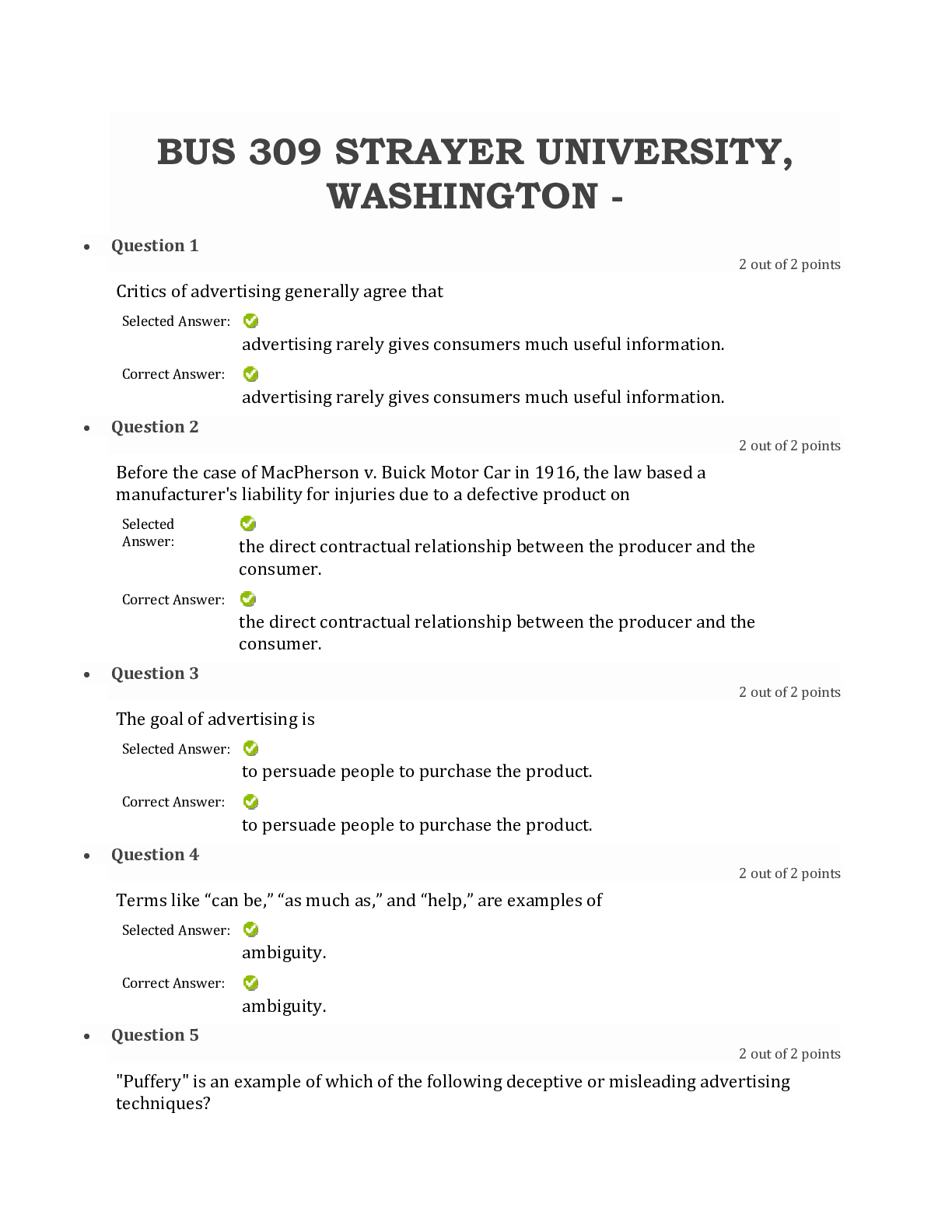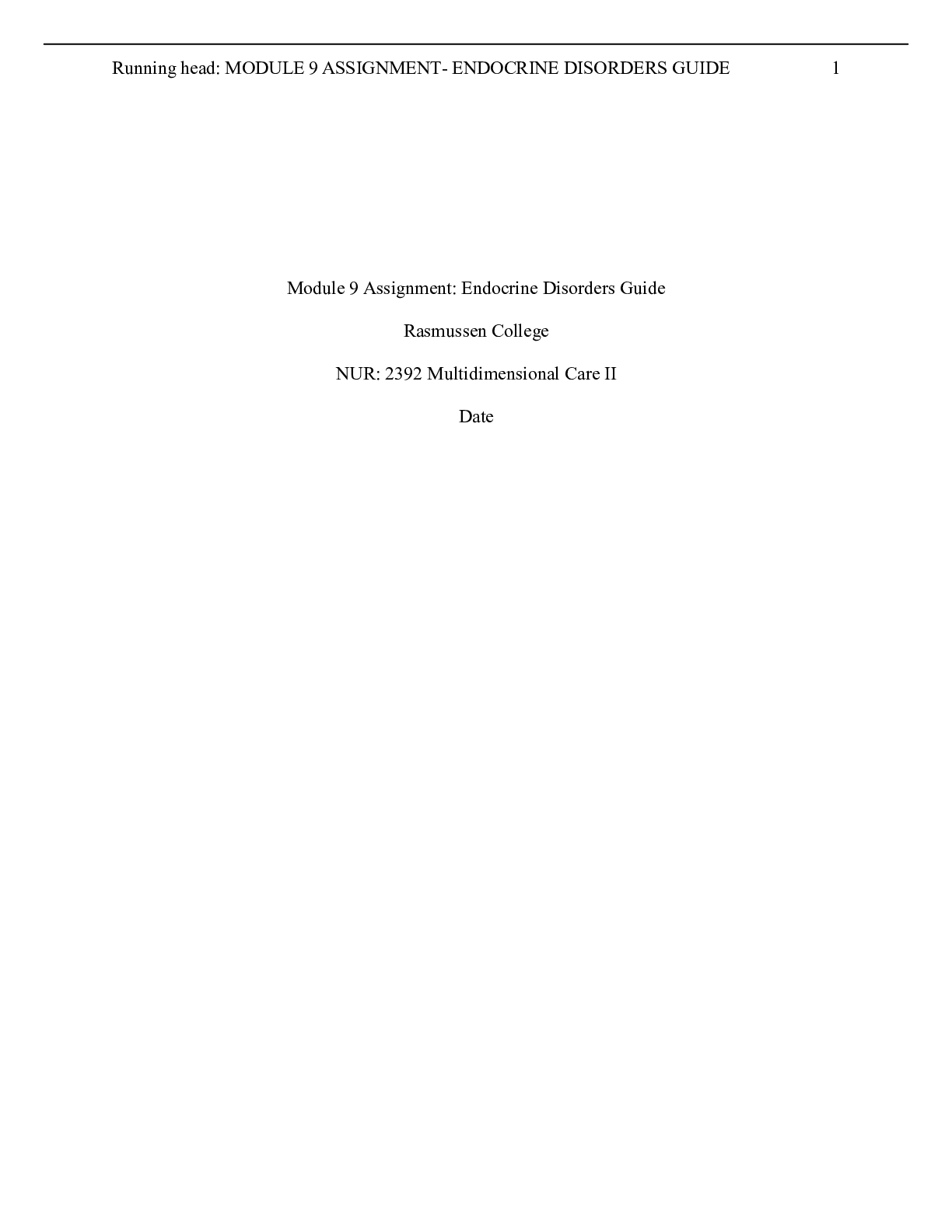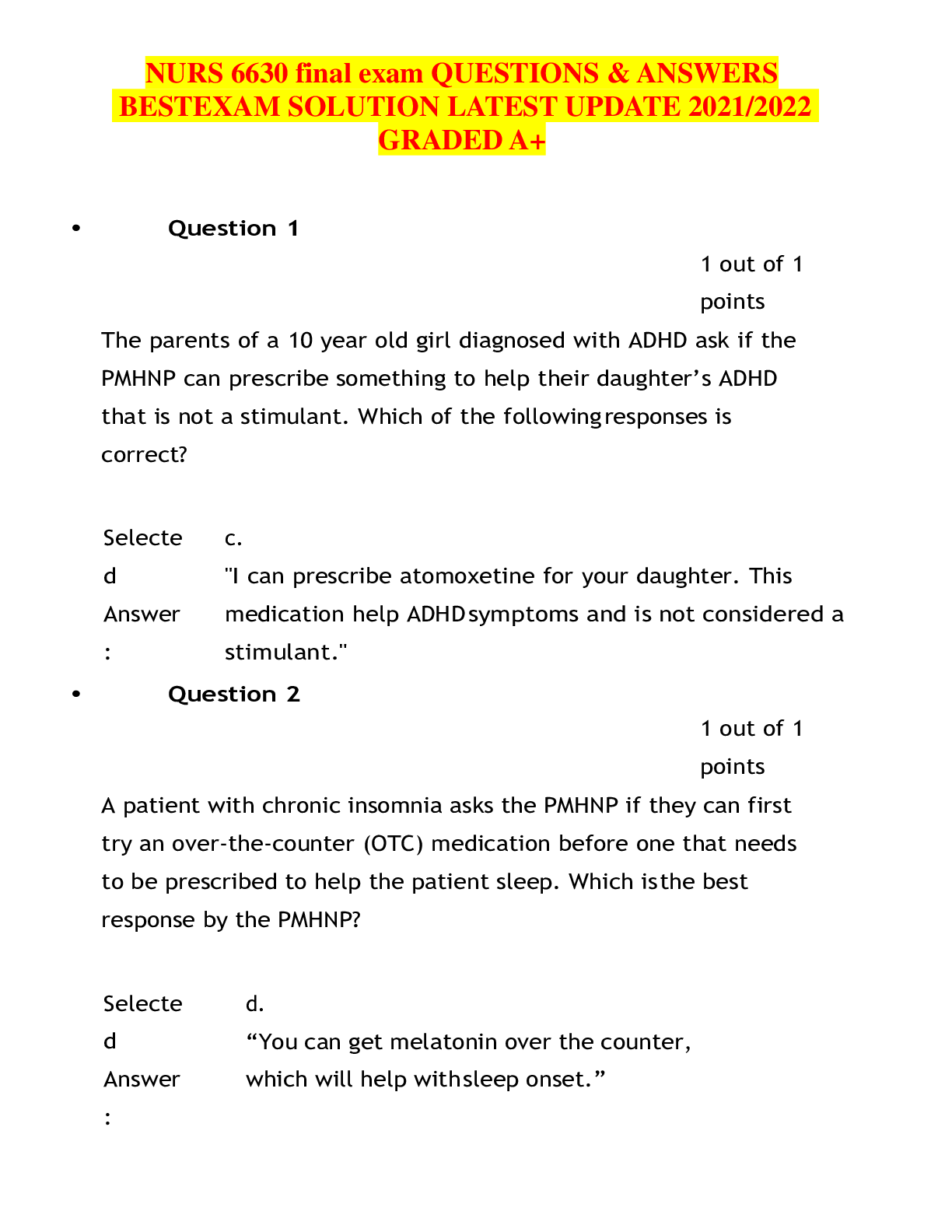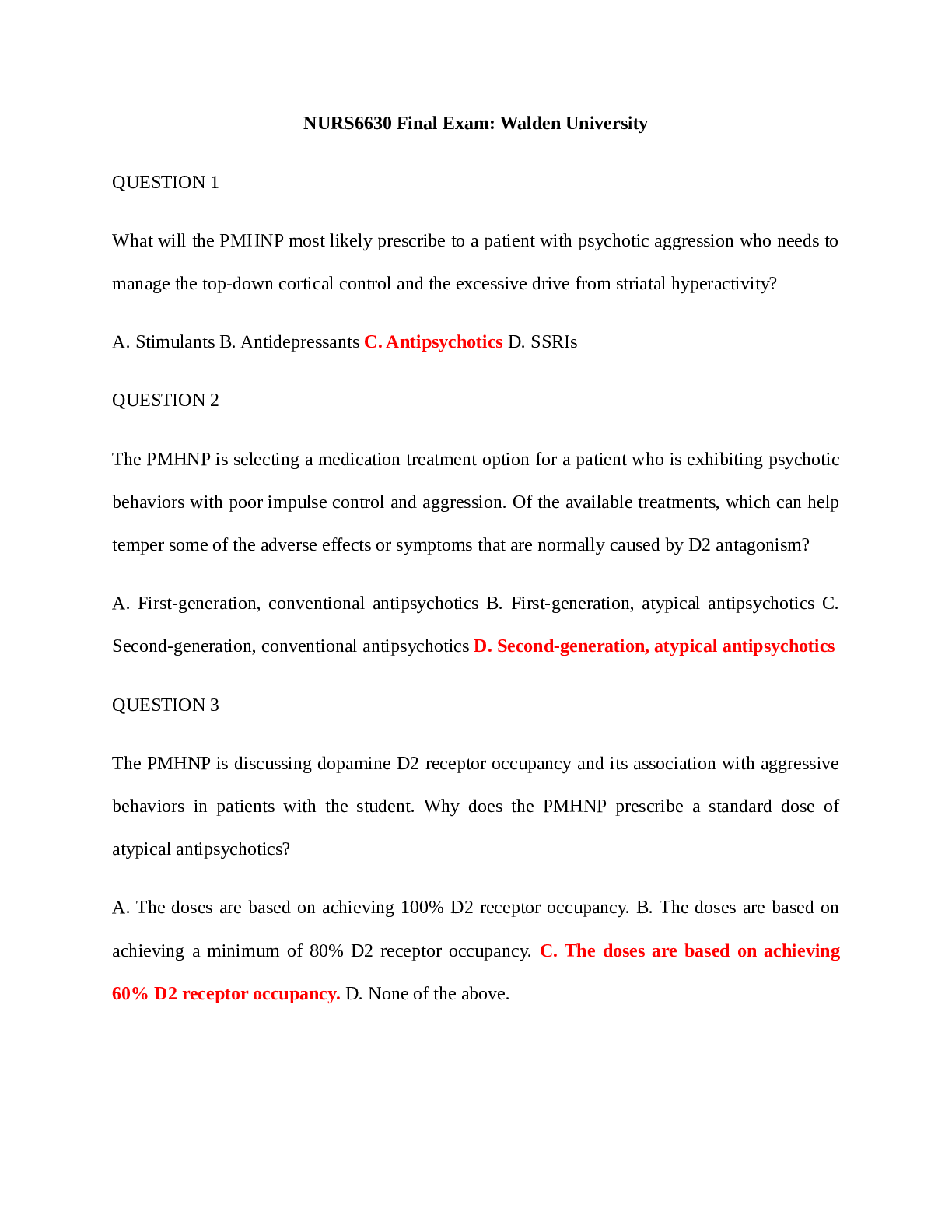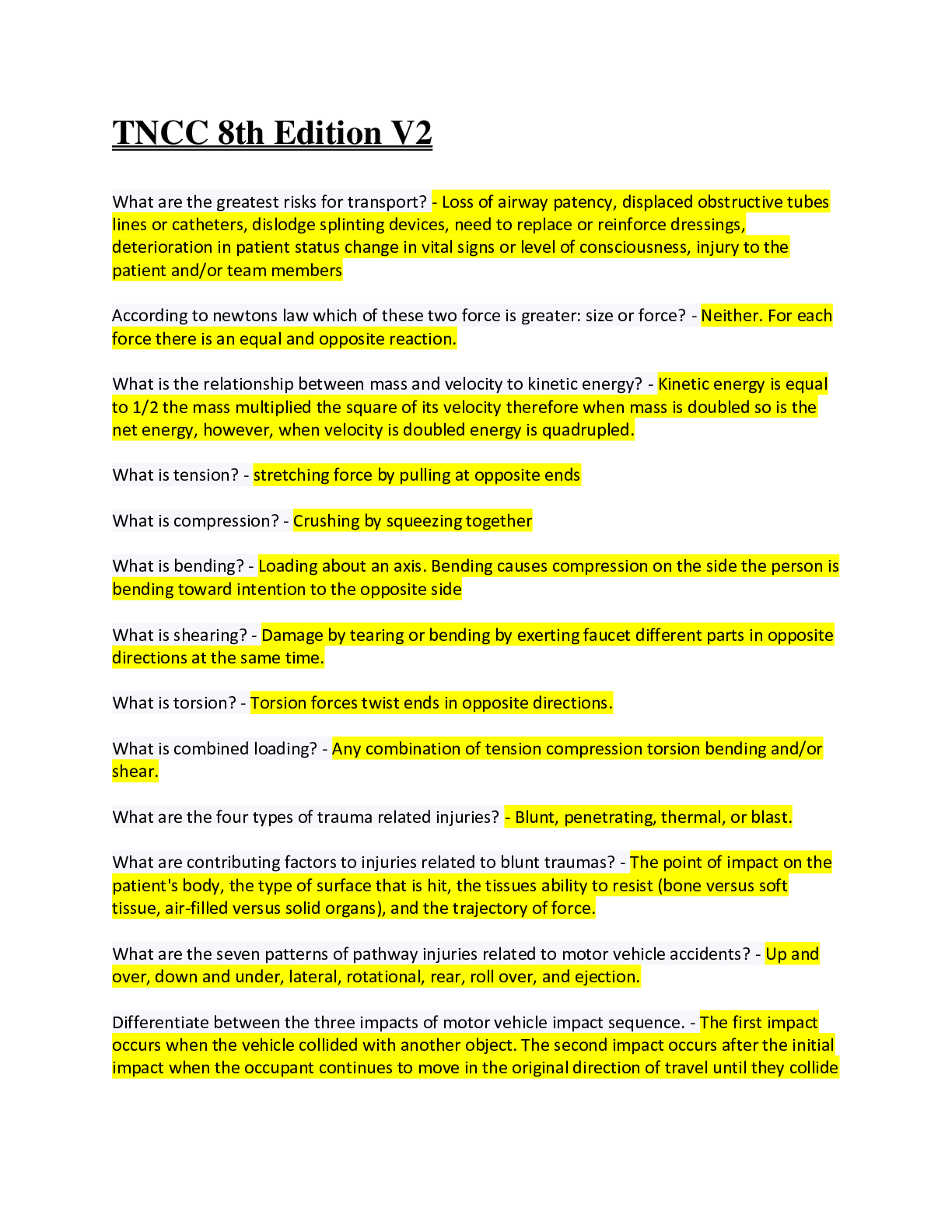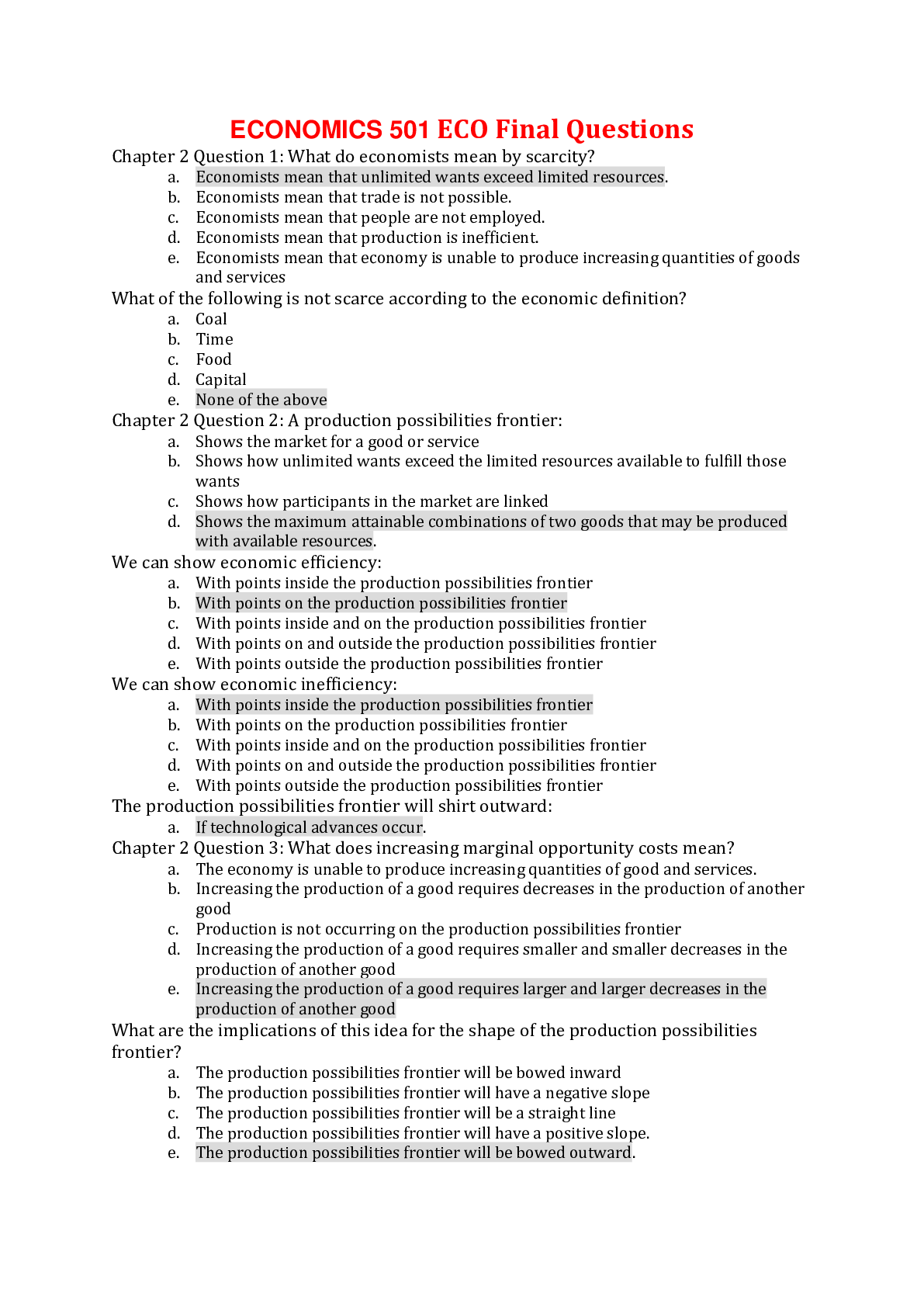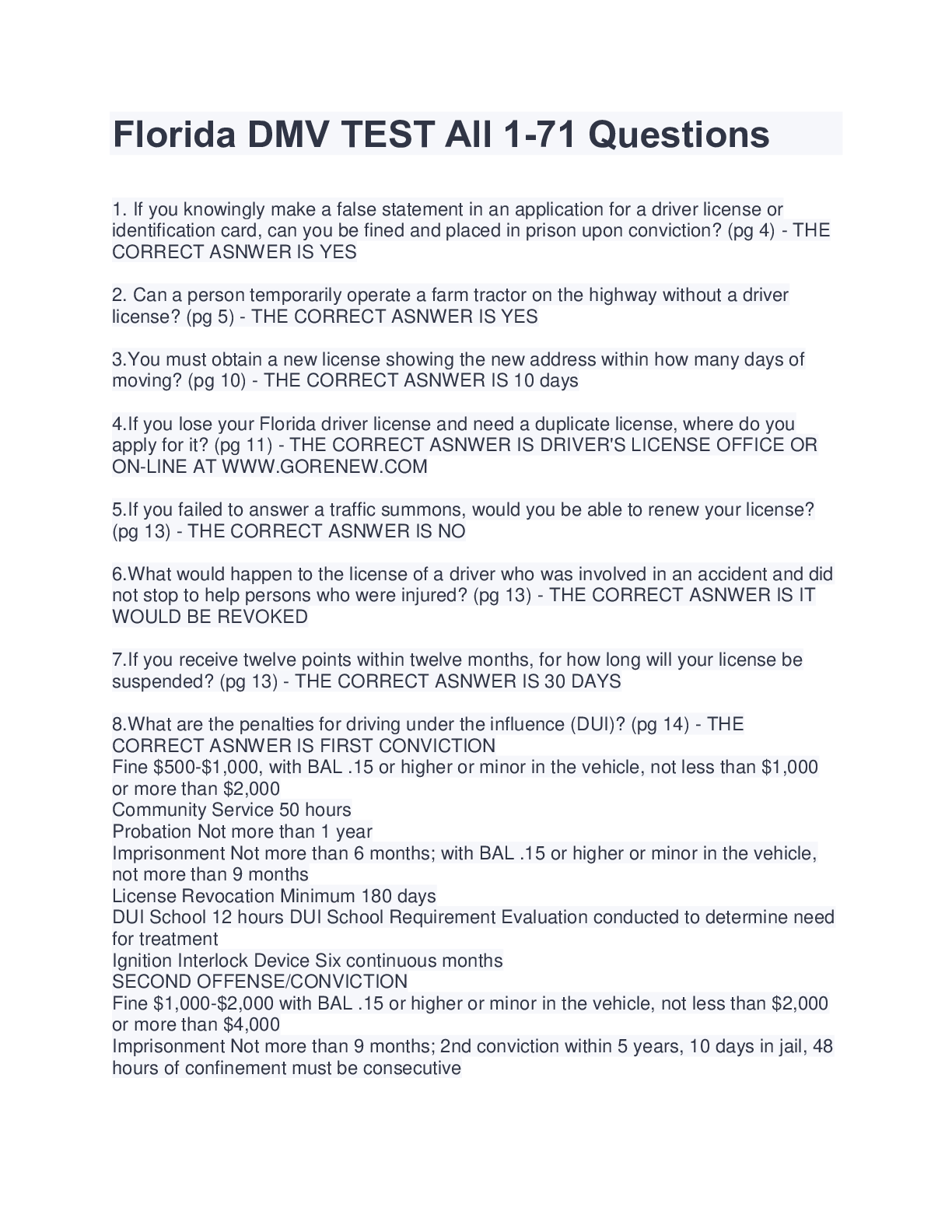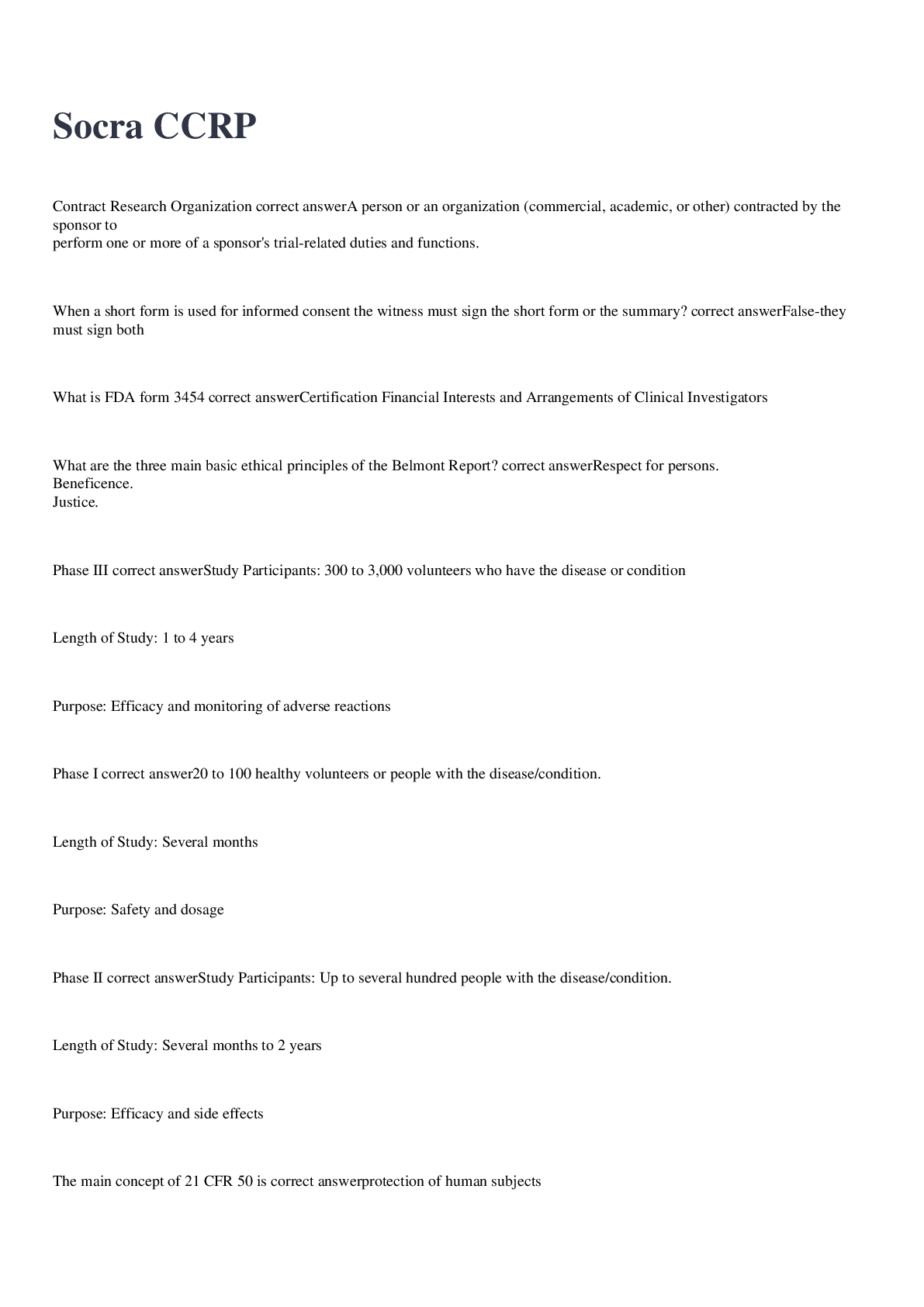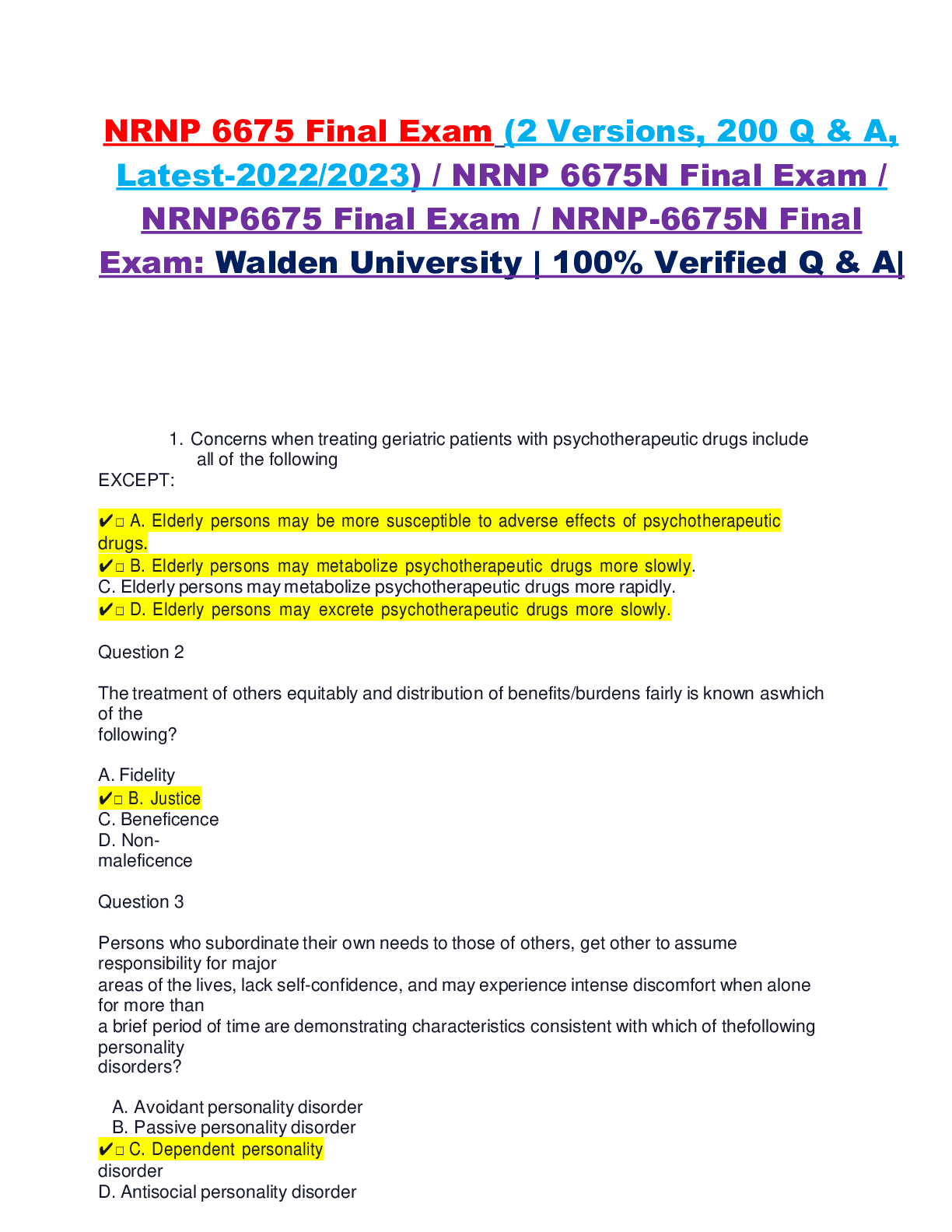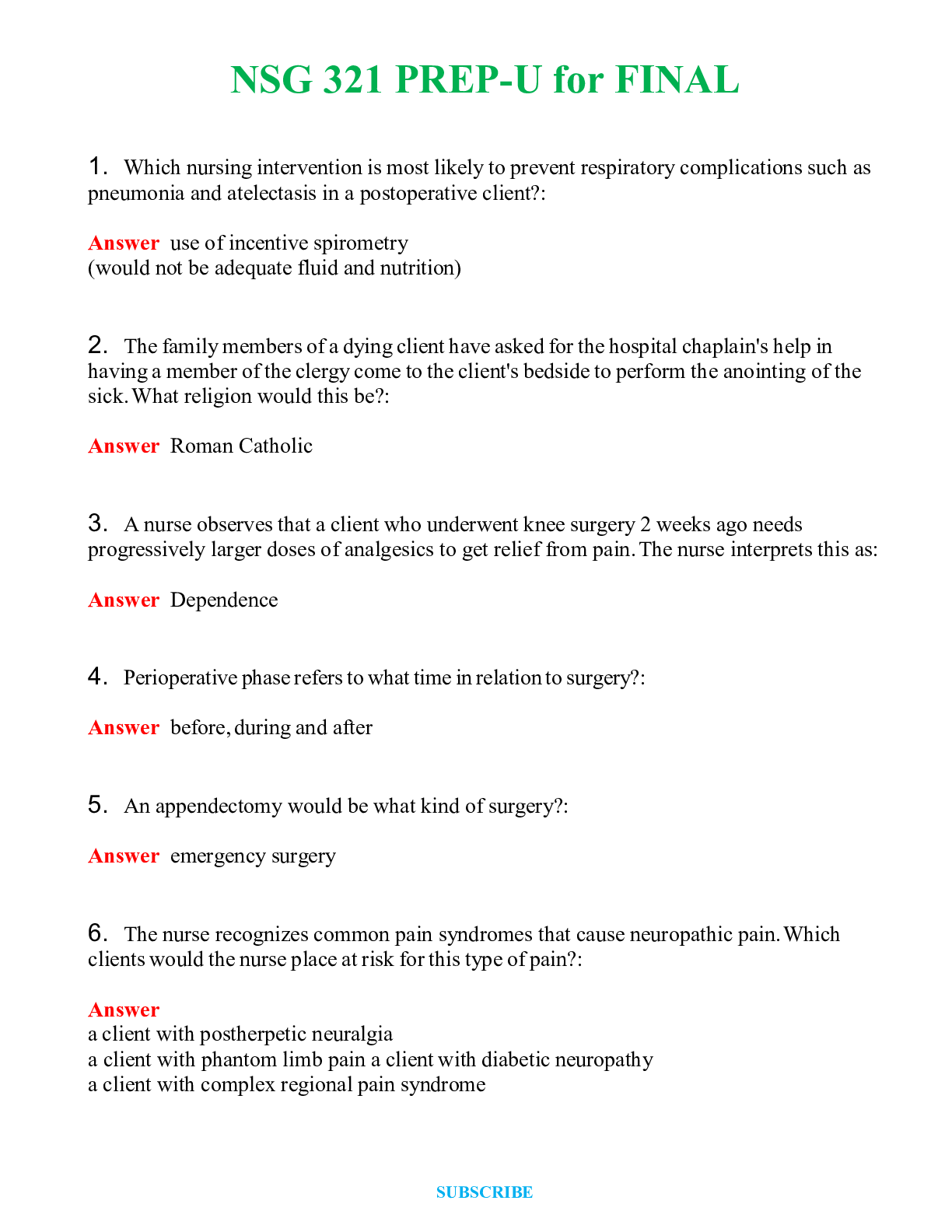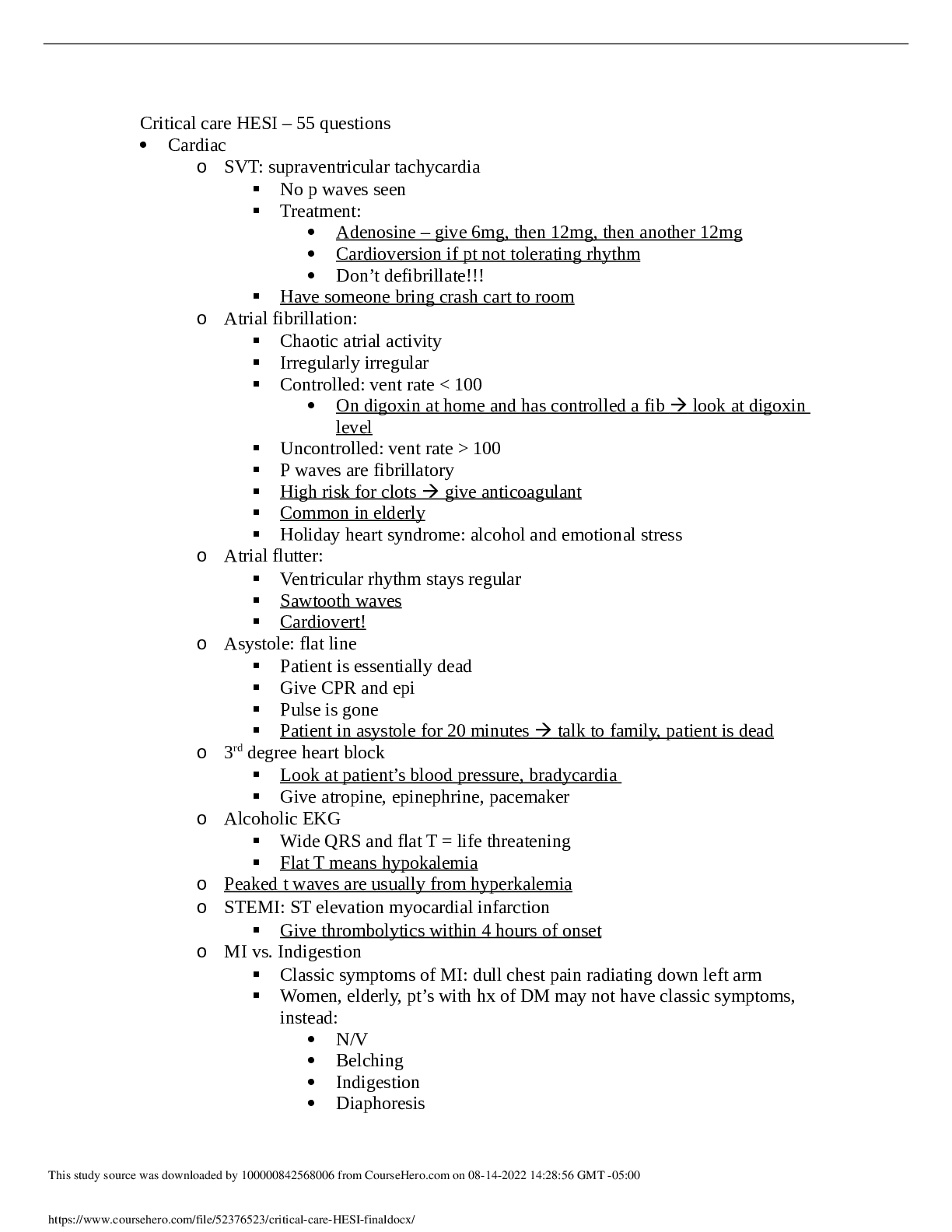Counseling > EXAM > CADC IL CADC Test Latest Exam Guide Completed (All)
CADC IL CADC Test Latest Exam Guide Completed
Document Content and Description Below
CADC IL CADC Test Latest Exam Guide Completed CADC IL CADC Test Latest Exam Guide Completed 1. A wife refers her husband for substance abuse counseling. His drug of choice is cocaine, which he has... been using episodically with friends at a poker game—biweekly to weekly—for some years. She is disturbed at the illicit nature of the drug and the long-standing use. He states that though he recreationally uses, he doesn't crave cocaine, doesn't seek it out but rather uses with friends at the game who bring it. He feels that other than his wife being upset, he has no other social or occupational issues. Given the information provided, how is his use of cocaine BEST described? a. Substance abuse b. Cocaine intoxication c. Cocaine use disorder d. None of the above d. None of the above 2. What does the experienced effect of a drug depend upon? a. The amount taken and past drug experiences b. The modality of administration c. Polydrug use, setting, and circumstance d. All of the above d. All of the above 3. How is drug tolerance BEST described? a. The inability to get intoxicated b. The need for less of a drug to get intoxicated c. Increased sensitivity to a drug over time d. Decreased sensitivity to a drug over time d. Decreased sensitivity to a drug over time 4. Which of the following is NOT a "drug cue"? a. A prior drug-use setting b. Drug use paraphernalia c. Seeing others use drugs d. Drug avoidance strategies d. Drug avoidance strategies 5. What happens as tolerance for barbiturates develops? a. The margin between intoxication and lethality increases b. The margin between intoxication and lethality decreases c. The margin between intoxication and lethality stays the same d. Tolerance does not develop for barbiturates c. The margin between intoxication and lethality stays the same 6. What is the MOST common symptom of Wernicke's encephalopathy? a. New memory formation b. Loss of older memories c. Psychosis d. Confusion d. Confusion 7. Which of the following conditions does alcohol NOT induce? a. Steatosis b. Nephrosis c. Hepatitis d. Cirrhosis b. Nephrosis 8. What does formication refer to? a. The creation of freebase cocaine b. Sex between two unmarried individuals c. A sensation of bugs crawling under the skin d. Extrapyramidal symptoms of agitation c. A sensation of bugs crawling under the skin 9. What is/are the organ(s) most damaged by cocaine abuse? a. The brain b. The lungs c. The kidneys d. The heart d. The heart 10. Which of the following is NOT a basic chemical class of amphetamines? a. Amphetamine sulphate b. Phenethylamine c. Dextroamphetamine d. Methamphetamine b. Phenethylamine 11. In terms of difficulty quitting (dependence), which of the following four drugs ranks the highest? a. Alcohol b. Cocaine c. Heroin d. Nicotine d. Nicotine 12. Which of the statements below is MOST correct? a. THC content in all marijuana is about the same. b. THC content in hashish is lower than in a joint. c. THC content in marijuana is predictable. d. THC content in marijuana varies widely. d. THC content in marijuana varies widely. 13. Regarding substance abuse, what does Convergence Theory propose? a. Rates of substance abuse among women are converging with those of men. b. All individuals eventually narrow drug use to a drug of choice preference. c. Age is a key factor in eventual substance abuse abstinence. d. As individuals age, gender disparities in rates of abuse tend to converge. a. Rates of substance abuse among women are converging with those of men. 14. Among psychiatric disorders in the elderly, where does alcohol abuse rank? a. twenty-fifth b. fifteenth c. fifth d. third d. third 15. Which of the following subcategories of alcohol use disorder onset is NOT found in the elderly? a. Late-onset alcoholism b. Delayed-onset alcoholism c. Late-onset exacerbation drinking d. Early-onset alcoholism d. Early-onset alcoholism 16. At an initial meeting with a new client, what is the FIRST requirement? a. Establish rapport. b. Evaluate readiness for change. c. Review rules and expectations. d. Discuss confidentiality regulations. a. Establish rapport. 17. What does motivational interviewing primarily involve? a. Focused confrontation b. Behavioral accountability c. Reality testing d. Supportive persuasion d. Supportive persuasion 18. What percentage of individuals with a dual diagnosis (co-occurring disorders [COD]—i.e., substance abuse disorder and an existing mental illness) received treatment for only their mental illness? a. 32.9 percent b. 27.6 percent c. 12.4 percent d. 8.8 percent a. 32.9 percent 19. What factors can affect screening instrument validity? a. The screening setting and privacy b. The levels of rapport and trust c. How instructions are given and clarified d. All of the above d. All of the above 20. Which of the following functions is NOT what a Certified Alcohol and Drug Abuse Counselor can usually perform? a. Client screening b. Substance abuse assessment c. Diagnose mental disorders d. Formulate a treatment plan c. Diagnose mental disorders 21. What does the acronym GATE stand for? a. Gather information; Access supervision; Take responsible action; Extend the action b. Gather resources; Access procedures; Take clinical notes; Extend the intervention c. Gather documentation; Access contacts; Take counsel; Extend positive outcomes d. Gather the team; Access records; Take consultation; Extend documentation a. Gather information; Access supervision; Take responsible action; Extend the action 22. To which of the following do assessment processes and instruments NOT need be sensitive? a. Political orientation b. Age and gender c. Race and ethnicity d. Disabilities a. Political orientation 23. What are serious mental health symptoms that resolve with abstinence in thirty days or less MOST likely due to? a. A resolution of transient situational stressors at home, school, or work b. A serious underlying mental disorder that temporarily improved c. Substance abuse-induced disorders that require continued abstinence d. Malingering to manipulate circumstances for underlying goals c. Substance abuse-induced disorders that require continued abstinence 24. Which one of the following alcohol abuse screening tests is designed specifically for use with adolescents? a. CAGE b. CRAFFT c. MAST d. AUDIT b. CRAFFT 25. Which of the following is the MOST important introductory statement or question to ask in a suicidality evaluation? a. Have you ever tried to take your own life? b. Do you have thoughts about killing yourself? c. I need to ask you a few questions about suicide. d. Have you ever attempted suicide? c. I need to ask you a few questions about suicide. 26. What is the purpose of screening? a. To prepare the client for program admission b. To determine client readiness for change c. To establish client diagnoses and treatment needs d. To determine the need for placement or referral d. To determine the need for placement or referral 27. What is the primary purpose of substance abuse assessment? a. To determine the current level of health deterioration b. To identify a substance abuser's drug of choice c. To provide co-occurring disorder(s) diagnosis d. To determine the severity of the substance problem d. To determine the severity of the substance problem 28. Who should create a treatment plan? a. A multidisciplinary team of professionals b. Collaborative team with the client c. The primary treatment provider d. A professional boilerplate to ensure completeness b. Collaborative team with the client 29. How must assessment information be handled to be the MOST effective? a. Carefully documented b. Converted into goals and objectives c. Available to all treatment providers d. Summarized with the client for feedback b. Converted into goals and objectives 30. Which of these key elements does NOT bolster a client's desire to complete the program? a. Knowledge of the benefits of treatment b. Understanding of the treatment process c. Fully assuming the patient role d. Frequent interdisciplinary consultations d. Frequent interdisciplinary consultations 31. How many levels of treatment placement are recognized by the American Society of Addiction Medicine (ASAM)? a. Two levels of treatment placement b. Four levels of treatment placement c. Six levels of treatment placement d. Eight levels of treatment placement b. Four levels of treatment placement 32. How many Assessment Dimensions are recognized by the American Society of Addiction Medicine (ASAM)? a. Two assessment dimensions b. Four assessment dimensions c. Six assessment dimensions d. Eight assessment dimensions c. Six assessment dimensions 33. The term "drug use trajectory" refers to: a. Individual drug use patterns over the lifespan b. The rate at which a given drug enters the body c. Drug metabolism over time d. Behavioral patterns of intoxication a. Individual drug use patterns over the lifespan 34. Circumstances, Motivation, Readiness, and Suitability (CMRS) Scales are used for what purpose? a. Assessing client readiness for treatment b. Assessing various financial and family support domains c. Assessing client suitability for research participation d. Assessing clients for treatment level of care a. Assessing client readiness for treatment 35. When is a client fully prepared to enter treatment? a. Treatment is court ordered. b. Family pressures a client to enter treatment. c. Job-based drug testing creates a clear need. d. A client accepts the need for treatment. d. A client accepts the need for treatment. 36. Guiding principles in treatment planning are identified by which acronym? a. MTSRA b. MATRS c. MSRTA d. MRAST b. MATRS 37. In cases involving the criminal justice system, what is the minimum recommendation for frequency of updating treatment plans? a. Following sentencing b. Upon release to a community setting c. At all transition points d. Both A and B c. At all transition points 38. How many problem domains are addressed in the Addiction Severity Index (ASI)? a. Six b. Eight c. Ten d. Twelve a. Six 39. The Addiction Severity Index has been formally adopted by which organization? a. The Substance Abuse and Mental Health Services Administration (SAMHSA) b. The Center on Drug and Alcohol Research (CDAR) c. The National Institute on Drug Abuse (NIDA) d. The Institute for Governmental Service and Research (IGSR) c. The National Institute on Drug Abuse (NIDA) 40. What does it mean if an assessment instrument is valid? a. The instrument is licensed for use by professionals. b. The instrument consistently provides accurate information. c. The instrument has been approved by the government for use. d. The instrument assesses what it purports to assess. d. The instrument assesses what it purports to assess. 41. All of the following are true of depression and substance abuse EXCEPT that a. drugs of abuse can successfully treat depression. b. depression can lead to self-medication with drugs of abuse. c. drugs of abuse can induce symptoms of depression. d. drugs of abuse can worsen symptoms of depression. a. drugs of abuse can successfully treat depression. 42. How does motivation for participating in treatment differ from motivation to change behaviors? a. There is no difference between treatment and behavior change motivation. b. Motivation for behavioral change precedes motivation for treatment. c. Motivation for change is internal; treatment may be pushed on a client. d. Motivation for treatment precedes motivation for behavioral change. c. Motivation for change is internal; treatment may be pushed on a client. 43. What of the following is NOT a key component in a treatment plan? a. Problem statements from the intake assessment b. Goal statements derived from problem statements c. Objectives, which are what the client will do to meet treatment goals d. The theoretical approach to be operationalized via treatment d. The theoretical approach to be operationalized via treatment The key components of a treatment plan include: (1) problem statements, which are based on information obtained during the assessment; (2) goal statements, which are derived from the problem statements; (3) objectives, which consist of what the client will do to meet treatment goals; and (4) interventions, which are defined as what the staff will do to assist the client. 44. What does the SOAP progress note acronym stand for? a. Subjective, Overview, Actions, and Plan b. Subjective, Objective, Assessment, and Plan c. Subjective, Observation, Assessment, and Plan d. Subjective, Overview, Attention, and Plan b. Subjective, Objective, Assessment, and Plan 45. What does the DAP progress note acronym stand for? a. Description, Assessment, and Progress b. Details, Assessment, and Progress c. Documentation, Actions, and Pending d. Data, Assessment, and Plan d. Data, Assessment, and Plan 46. The mnemonic DIG-FAST evaluates which psychological state? a. Depression b. Anxiety c. Paranoia d. Mania d. Mania D) distractibility (easily distracted as evidenced by an inability to concentrate), I) indiscretion (excessive pleasure activities), G) grandiosity (larger-than-life feelings of superiority, wealth, power, etc., often experienced during manic, hypomanic or mixed episodes), F) flights of ideas (mind is racing, seemingly unable to control or slow down thoughts), A) activity (markedly increased activity, with weight loss and increased libido), S) sleep deficit (unable to sleep for extended periods well below normal sleep needs but not drug induced), T) talkativeness (pressured speech: rapid, virtually nonstop, often loud and emphatic, seemingly driven, and usually hard to interrupt). 47. How does the Center for Substance Abuse Treatment (CSAT) recommend that substance abuse be considered and treated? a. A psychological disorder b. An acute disease c. A chronic treatable condition d. A degenerative treatable disorder c. A chronic treatable condition 48. How does the Center for Substance Abuse Treatment (CSAT) indicate that treatment or interventions provided following discharge from a formal inpatient or outpatient program be referred to? a. After care b. Continuing care c. Follow-up care d. Post-discharge care b. Continuing care 49. What is the BEST distinction between substance abuse treatment programs and mutual-help groups, such as a twelve-step support groups? a. Programs offer help, and groups offer support. b. Programs are expensive, and groups are free. c. Programs are run by professionals, and groups are run by laypersons. d. Programs offer treatment, and groups offer support. d. Programs offer treatment, and groups offer support. 50. According to the American Society of Addiction Medicine (ASAM), what is the minimum of treatment time the intensive outpatient treatment (IOT) must provide? a. Three hours of treatment per week b. Six hours of treatment per week c. Nine hours of treatment per week d. Twelve hours of treatment per week c. Nine hours of treatment per week 51. Which of the following is NOT a core feature or service that the Center for Substance Abuse Treatment (CSAT) consensus panel agreed upon? a. Biopsychosocial assessment b. Individualized treatment planning c. Case management d. Recreational therapy d. Recreational therapy 52. Which form of substance abuse is naltrexone used to treat? a. Alcohol dependence b. Opioid dependence c. Both A and B d. Neither A nor B c. Both A and B 53. Which of the following is NOT a core treatment and recovery skill? a. Stress management b. Substance refusal training c. Exercise and health training d. Relaxation training c. Exercise and health training 54. Which of the following is NOT a primary learning style? a. Gustatory b. Kinesthetic c. Auditory d. Visual a. Gustatory 55. What is the influence of family on treatment outcomes? a. Treatment outcomes are improved with family support. b. Treatment outcomes are worse with family involvement. c. Both A and B d. Neither A nor B c. Both A and B 56. How many main levels exist in the substance abuse continuum of care, according to the American Society of Addiction Medicine (ASAM)? a. Three levels of care b. Four levels of care c. Five levels of care d. Six levels of care c. Five levels of care Level 0.5: early intervention services (subclinical or pretreatment, exploring risks and addressing problems or risk factors that appear to be related to substance use); Level I: outpatient services (nonresidential, less than nine hours per week); Level II: intensive outpatient or partial hospitalization services— nonresidential, a minimum of nine hours per week (Level II is subdivided into levels II.1 and II.5); Level III: residential or inpatient services—minimum of twenty-five hours per week (Level III is subdivided into levels III.1, III.3, III.5, and III.7); and Level IV: medically managed intensive inpatient services (subacute, with daily physician supervision). These levels are not discrete but rather points on a treatment continuum. 57. How many sequential stages must outpatient clients work through, regardless of the level of care at which they enter treatment? a. Two stages b. Four stages c. Six stages d. Eight stages b. Four stages Stage 1—treatment engagement (establish a treatment contract including goals and client responsibilities; resolve acute crises; develop a therapeutic alliance; and prepare a treatment plan); Stage 2—early recovery (continue abstinence; sustain behavioral changes; terminate a drug-using lifestyle and develop drug-free alternatives; learn relapse triggers and prevention strategies; identify and resolve contributing personal problems; and begin a twelve-step or mutual-help program); Stage 3—maintenance (solidify abstinence; deepen relapse prevention skills; enhance emotional functioning; increase sober social networks; and address other problem areas); Stage 4—community support (sustain abstinence and a healthy lifestyle; establish treatment independence; extend social network and support group connections; pursue healthy community activities; and solidify important outlet activities and pursue new interests). 58. What is the usual recommended minimum duration of days for the intensive outpatient treatment (IOT) phase? a. Thirty days b. Sixty days c. Ninety days d. One hundred twenty days c. Ninety days 59. How is the MOST effective relapse-prevention training provided? a. Group therapy is more effective. b. Individual therapy is more effective. c. Structured classes are more effective. d. A and B are roughly equal in effectiveness. d. A and B are roughly equal in effectiveness. 60. Which of the following is NOT a type of intensive outpatient treatment (IOT) group? a. Psychoeducational groups b. Skills development groups c. Interpersonal process groups d. Transitional care groups d. Transitional care groups 61. What is the MOST common duration of counseling in an intensive outpatient treatment (IOT) program? a. Twenty to thirty minutes, one time each week b. Thirty to fifty minutes, one time each week c. Forty to sixty minutes, one time each week d. Thirty to fifty minutes, two times each week b. Thirty to fifty minutes, one time each week 62. How are pharmacotherapy and medication management in substance abuse treatment described? a. Of little importance outside a hospitalization program b. Of some but limited value but without a central role c. Of moderate value in treatment but not crucial d. Of considerable, albeit limited, value in treatment d. Of considerable, albeit limited, value in treatment 63. Topics addressed in psychoeducational groups are typically a. sequenced by concept for maximal effectiveness. b. presented as requested or needed by group participants. c. selected randomly by the group educator or presenter. d. determined by the group’s prevailing drug of choice. a. sequenced by concept for maximal effectiveness. 64. What was the original CIWA-Ar scale designed for? a. Evaluation of opioid withdrawal risk b. Evaluation of amphetamine withdrawal risk c. Evaluation of alcohol withdrawal risk d. Evaluation of benzodiazepine withdrawal risk c. Evaluation of alcohol withdrawal risk 65. Which of the following substances lack effective treatment medications? a. Cocaine b. Marijuana c. Both of the above d. Neither of the above c. Both of the above 66. Adjunctive therapies refer to all EXCEPT which of the following? a. Vocational training b. Stress management c. Meditation d. Acupuncture a. Vocational training 67. Dealing with smoking cessation during a substance abuse treatment program is a. something too overwhelming for the majority of individuals. b. something that should not be brought up by anyone but the client. c. something to be seriously considered if the client desires it. d. something that should be required during any treatment program. c. something to be seriously considered if the client desires it. 68. Disulfiram (Antabuse) is contraindicated for clients whose alcohol abuse is combined with which of the following circumstances? a. Cocaine use b. Methadone use c. Both cocaine and methadone use d. None of the above d. None of the above 69. What is the sandwich technique? a. A method to increase health food intake b. An intake interviewing technique c. Client pairing for optimal treatment support d. Staff pairing for optimal treatment support b. An intake interviewing technique 70. Which of the following was NOT identified as being among the three MOST effective screening tools for substance use disorders? a. The CSAT Simple Screening Instrument b. The Alcohol Dependence Scale (ADS) and the Addiction Severity Index (ASI)-Drug Use Subscale combined c. The Substance Abuse Screening Instrument d. The Texas Christian University Drug Screen c. The Substance Abuse Screening Instrument 71. What is the SDSS designed to measure? a. Substance-induced depression over time b. Variations in polysubstance use over time c. Drug use disorder severity over time d. Severity and duration of intoxication symptoms c. Drug use disorder severity over time The Substance Dependence Severity Scale (SDSS) is a structured interview that provides current (last thirty days) DSM and ICD-10 substance use disorders and harmful use diagnoses. The instrument measures the quantity and frequency of recent drug use, which directly translates into variations in clients' clinical status. 72. What is the primary purpose of the Texas Christian University Drug Screen (TCUDS)? a. To identify those with versus those without issues of drug dependency b. To establish a roster of the kinds and severity of drugs used in the past c. To evaluate dangerousness and risk taking in drug use patterns d. To correlate drug use patterns with emerging health concerns a. To identify those with versus those without issues of drug dependency 73. What is physiological dependence on a drug determined by? a. The addictive properties of the drug b. Tolerance or symptoms of withdrawal c. A psychological need to again use the drug d. Frequency and amount of the drug taken b. Tolerance or symptoms of withdrawal 74. According the DSM-5 criteria, a client that has previously met the criteria for stimulant use disorder but now has not met the criteria for stimulant use in 10 months (except for craving) would be termed to be in ______ remission. a. Full b. Partial c. Early d. Sustained c. Early 75. What is a client’s family of choice used to describe? a. Step-parents and step- and half-siblings b. Common-law relationships only c. Planned pregnancies as opposed to those unplanned d. Relationships created by marriage, friendship, and other associations d. Relationships created by marriage, friendship, and other associations 76. What does a dual relationship refer to? a. Dyads assigned in addiction-recovery groups for added support b. The sponsor–sponsee relationship in twelve-step groups such as A.A. c. The mentor relationship with those newly entering addiction treatments d. A working relationship with a client outside the professional domain d. A working relationship with a client outside the professional domain 77. What is an appropriate response to a substantial gift from a client? a. “You shouldn’t have!” b. “Thank you so much!” c. “I can’t accept that, but thank you!” d. “A gift like that is not appropriate.” c. "I can't accept that, but thank you!" 78. Two clients in a treatment group begin dating. What would a proper response be? a. Address program policy preventing dating among group members. b. Initiate a group activity to acknowledge their new relationship. c. Terminate treatment for both of the members. d. Terminate treatment for one of the members. a. Address program policy preventing dating among group members. 79. At a local dance club, a counselor spots a client drinking at the bar. What is the BEST response to this? a. Confront the client immediately, encouraging him or her to leave the club. b. Quietly find a moment to talk with the client privately at the club. c. Avoid contact with the client, and leave the club immediately. d. Avoid contact with the client, but remain at the club. c. Avoid contact with the client, and leave the club immediately. 80. As a substance abuse counselor, you work in a treatment program and also personally attend a twelve-step program in the community. A treatment program client asks you to become his or her twelve-step sponsor. What is the proper, thoughtful response? a. Accept, knowing that it may benefit the therapeutic alliance. b. Accept, knowing how much this client needs help. c. Decline, concerned that the client could be difficult to support. d. Decline, recognizing the potential conflicts in multiple roles. d. Decline, recognizing the potential conflicts in multiple roles. 81. In providing counseling treatment, what are counselors encouraged to do? a. Select a single counseling approach, and refine it fully. b. Use multiple counseling approaches to meet clients’ needs. c. Avoid relying on any formal counseling technique. d. Recognize that all counseling techniques are equally effective. b. Use multiple counseling approaches to meet clients' needs. 82. What does the Twelve-Step Facilitation Approach refer to? a. Program counselors also serving as twelve-step group facilitators b. Twelve-step program facilitators working within a treatment program c. Teaching twelve-step principles during treatment program work d. Encouraging clients to enter a community twelve-step program d. Encouraging clients to enter a community twelve-step program 83. Which of the following is NOT a strength of twelve-step programs? a. Twelve-step meetings are free, widely available, and offer ongoing support. b. The twelve-step approach easily accommodates client diversity. c. Twelve-step programs offer easy monitoring of assigned step tasks. d. The twelve-step approach offers recovery in cognitive, health, and spiritual areas. c. Twelve-step programs offer easy monitoring of assigned step tasks. 84. Staff familiarity with twelve-step program facilitation is important because of all of the following EXCEPT that a. clients feel more pressure to attend twelve-step programs by these staff. b. clients are more easily motivated into twelve-step programs by these staff. c. clients' concerns are more meaningfully resolved by these staff. d. clients generally remain abstinent longer with twelve-step involvement. a. clients feel more pressure to attend twelve-step programs by these staff. 85. When outcomes from cognitive-behavioral coping skills therapy and motivational enhancement therapy are compared with outcomes from twelve-step facilitation, how do clients fare BEST? a. cognitive-behavioral coping skills therapy b. motivational enhancement therapy c. Twelve-step facilitation d. All the above c. Twelve-step facilitation 86. Traditionally, what has the term therapeutic community (TC) referred to? a. An informal group organized for mutual support b. A court-ordered treatment environment c. A formal mutual-help or twelve-step support group d. A drug-free residential treatment environment d. A drug-free residential treatment environment 87. Why do therapeutic communities (TCs) often focus on habilitation instead of rehabilitation? a. Many clients cannot successfully be rehabilitated. b. Rehabilitation is not as effective as habilitation. c. Habilitation helps clients learn new skills they never had. d. Rehabilitation focuses only narrowly on detoxification. c. Habilitation helps clients learn new skills they never had. 88. In what setting is the therapeutic community (TC) treatment model MOST effective? a. A formal full-time residential setting b. An intensive day treatment setting c. Neither A nor B, but in a support group setting d. A and B equally d. A and B equally 89. What is the MOST important reason that ordered and routine activities are built into the therapeutic community (TC) treatment process? a. To relieve boredom that may serve as a trigger for substance abuse b. To counter the typically disordered lives of substance-abusing clients c. To reduce the stress through focused programmed activities d. To distract from the negative thinking that may lead to substance abuse b. To counter the typically disordered lives of substance-abusing clients 90. What is the Matrix Model designed to treat? a. Stimulant abuse b. Alcohol abuse c. Barbiturate abuse d. Inhalant abuse a. Stimulant abuse 91. Which of the following is not a drawback to community reinforcement (CR) and contingency management (CM) approaches? a. CR and CM are most effective if used together. b. CR and CM are not enduringly effective. c. CR is labor intensive, and CM can be costly. d. CR requires others' support, and CM requires ongoing rewards. a. CR and CM are most effective if used together 92. With regard to co-occurring disorders, what does the term integrated treatment refer to? a. Meeting both medical and substance abuse treatment needs b. Using an eclectic treatment paradigm in the treatment process c. Incorporating sociocultural issues in the treatment process d. Treating both psychiatric and substance abuse issues concurrently d. Treating both psychiatric and substance abuse issues concurrently 93. What would be the MOST typical co-occurring disorder client? a. An alcohol-abusing man b. A drug-abusing man c. An alcohol-abusing woman d. A drug-abusing woman c. An alcohol-abusing woman 94. How many categories does SAMHSA's Service Coordination Framework for Co-Occurring Disorders have? a. Two categories b. Four categories c. Six categories d. Eight categories b. Four categories Category I—mental disorders, less severe + substance use disorders, less severe; locus of care is a primary health care setting; Category II—mental disorders, more severe + substance use disorders, less severe; locus of care is a mental health system; Category III—mental disorders, less severe + substance use disorders, more severe; locus of care is a substance use treatment system; and Category IV—mental disorders, more severe + substance use disorders, more severe; locus of care is state hospitals, jails or prisons, emergency rooms, and so on. In the first category (low severity mental health and substance use), the bias is for basic primary care. The middle two categories involve a bias for treatment in concert with the severity level of the primary diagnosis. The last category recognizes that, when both psychiatric disturbances and drug use are severe, clients tend to need highly integrated, even locked, care settings. 95. When behaviorally assessing for a co-occurring disorder, what is the MOST important variable to consider? a. Alcohol or drug toxicity or withdrawal symptoms b. The client's denial of any psychiatric problems c. The client's family history of psychiatric disorders d. The client's immediate behavior a. Alcohol or drug toxicity or withdrawal symptoms 96. How are substance abuse treatment programs for adolescents described? a. Very different from treatment programs for adults b. Somewhat different from treatment programs for adults c. Minimally different from treatment programs for adults d. Not at all different from treatment programs for adults a. Very different from treatment programs for adults 97. What is the MOST effective treatment approach for adolescents, in terms of less drug use at treatment completion? a. Parent education b. Peer group therapy c. Family therapy d. Multifamily interventions c. Family therapy 98. How is the concept of culture BEST described? a. A shared set of beliefs, norms, and values among a racial group b. A shared set of beliefs, norms, and values among an ethnic group c. A shared set of beliefs, norms, and values among any given group d. A shared set of beliefs, norms, and values among a given nationality c. A shared set of beliefs, norms, and values among any given group 99. Who is primarily responsible for ensuring that treatment is effective for culturally diverse clients? a. The client b. The provider c. The institution d. The family b. The provider 100. What does the term culture-bound syndrome refer to? . a. An illness (mental or physical) unique to a cultural group b. An illness presenting or interpreted distinctively, due to cultural influence c. Both A and B d. Neither A nor B c. Both A and B 101. Beyond the culture of the client, what is another key cultural issue? a. Client's number of generations in the United States b. Clients living in cultural enclaves c. Culture of the counselor d. Client's primary language c. Culture of the counselor 102. What are the two key mental health treatment paradigms of Western medicine? a. Objectivity and the scientific method b. Theoretical and applied practice c. Pharmacological therapy and psychotherapy d. Biological and environmental perspectives c. Pharmacological therapy and psychotherapy 103. Racism may jeopardize the mental health of minorities in all of the following ways EXCEPT that a. negative racial images and stereotypes adversely affect social and psychological function. b. racism and discrimination result in diminished socioeconomic status, where poverty, crime, and violence affect mental health. c. racism and discrimination lead to physiological changes and psychological distress that affect mental health. d. discrimination and racism limit recreational and leisure opportunities to improve mental health. d. discrimination and racism limit recreational and leisure opportunities to improve mental health. 104. What is the trend for cultural diversity in the United States? a. Decreasing slowly but steadily b. Remaining approximately unchanged c. Increasing slowly but steadily d. Increasing rapidly and steadily d. Increasing rapidly and steadily 105. What is the difference between AIDS and HIV? a. HIV can be fatal; AIDS is a nonfatal chronic condition. b. HIV is a common viral illness, while AIDS is a lethal infection. c. HIV is the virus that causes the AIDS syndrome. d. HIV is sexually transmitted, while AIDS is acquired in other ways. c. HIV is the virus that causes the AIDS syndrome. 106. As compared with current older adults, what is the upcoming baby boomer generation (born between 1946 and 1964) expected to have? a. Much lower treatment needs b. Somewhat lower treatment needs c. Somewhat higher treatment needs d. Much higher treatment needs d. Much higher treatment needs 107. When older adults enter treatment, how do their rates of attendance and incidence of relapse, compare to their younger cohorts? a. Much higher attendance and much lower relapse rates b. Somewhat higher attendance and modestly lower relapse rates c. No real difference in attendance or relapse rates d. Much lower attendance and much higher relapse rates a. Much higher attendance and much lower relapse rates 108. Confidentiality requirements exist to protect client’s and their personal lives and information. Without a client signed information release, what is information that can be disclosed? a. A client’s enrollment in a treatment program only b. A report of child abuse suspected to be caused by the client c. A client’s name, age, gender, and race or ethnicity d. A report of progress to an employer paying for treatment b. A report of child abuse suspected to be caused by the client 109. The CAGE questionnaire is a four-question screening tool. What is this screening instrument designed to screen for? a. Cocaine abuse b. Marijuana abuse c. Alcohol abuse d. Heroin abuse c. Alcohol abuse (1) Have you ever felt the need to cut down on your drinking; (2) do you feel annoyed by people complaining about your drinking; (3) do you ever feel guilty about your drinking; and (4) do you ever drink an eye-opener in the morning to relieve the shakes? 110. The MAST screening test is a twenty-five-question instrument that is used to explore the degree and severity of a client’s problem with which type of abuse? a. Cocaine abuse b. Mescaline abuse c. Methamphetamine abuse d. Alcohol abuse d. Alcohol abuse 111. The relapse and remitting model addresses cycles of relapse and recovery common to addiction. What else can it be usefully applied to? a. Medication management b. Unemployment c. Issues of anger and violence d. All of the above d. All of the above 112. The term authentically connected referral network is used in conjunction with case management. How is it BEST defined? a. A resource directory of available community services to call as needed b. A set of defined relationships able to adapt and flexibly meet client needs c. A rolodex with key names and contacts for needed services d. An informal consortium of providers sharing information among each other b. A set of defined relationships able to adapt and flexibly meet client needs 113. In providing case management services, beyond providing seamless care and being client focused, what is the primary aim? a. Provide referrals to needed services in as timely a way as possible b. Determine how to integrate needed referrals in a coordinated fashion c. Produce the least-restrictive level of care possible in meeting the client’s needs d. Promote client self-determination in identifying and selecting needed services c. Produce the least-restrictive level of care possible in meeting the client's needs 114. Sensitive interviewing and engagement techniques are important to optimize client responsiveness and investment. What does the ask-tell-ask technique refer to? a. Asking permission of the client to talk with them, telling them of any concerns you have, and then asking for their thoughts on what you shared b. Asking clients what they understand, telling them where they are wrong, and asking again if they understand c. Asking clients for their opinions, telling them where their opinions are valid and workable, and then asking them if they concur d. Asking clients to listen, telling them what they need to know, and asking if they will acquiesce to what is being asked of them a. Asking permission of the client to talk with them, telling them of any concerns you have, and then asking for their thoughts on what you shared 115. After referrals are made, it is important to track the associated outcomes for measures of referral success. What are the three MOST important evaluative aspects? a. How, where, and when b. Why, what, and where c. Where, when, and who d. Who, what, and how d. Who, what, and how 120. In working with substance abuse clients, counselors must be aware specific guidelines found in the HIPAA statutes. What do these guidelines address? a. HIV counseling and practice guidelines b. Health privacy and confidentiality standards c. Health, addiction, and abuse practice guidelines d. Facility intake and admission policy standards b. Health privacy and confidentiality standards 116. Given a client’s history, referrals for co-occurring disorders as well as medical, educational, and psychological needs should be ongoing as discovered. When should planning for aftercare be engaged? a. During the last few sessions, addressing specific, continuing needs b. When a client is roughly halfway through a program c. After measurable progress has been demonstrated d. At the point of the initial counselor–client contact d. At the point of the initial counselor-client contact 118. In a client’s efforts to maintain emotional and psychological balance, what does the term bookend refer to? a. Discussing a trigger event with someone trusted before and after it occurs b. Fully reading and applying reference literature provided in the program c. Remaining steadfast even in the face of temptation to abuse a substance d. Keeping a difficult issue on the shelf until it can be better dealt with a. Discussing a trigger event with someone trusted before and after it occurs 119. In working with substance-abusing clients, counselors must be aware of the applicable guidelines in CFR Title 42 Part 2. What do the guidelines deal with? a. Substance abuse treatment program accreditation and standards b. Issues involving the illicit manufacture and sale of drugs of abuse c. Confidentiality in areas of alcohol and substance abuse d. Mandated client treatment under a court directive or order c. Confidentiality in areas of alcohol and substance abuse 130. Substance abuse affects not only the user but the family as well. What are intergenerational affects MOST commonly caused by? a. The legal system, with incarceration, unemployment, and family separation b. Compensating issues needed to cope with addictive dysfunction c. The counseling system, pushing families to encounter an addict’s issues d. Society, rejecting the addict and all those associated with him or her b. Compensating issues needed to cope with addictive dysfunction 117. Substance-induced disorders refer specifically to: a. Poor occupational functioning when abusing substances b. Dysfunctional family interactions secondary to substance abuse c. Psychiatric symptoms brought on by substance abuse d. Physical ailments brought on by substance abuse c. Psychiatric symptoms brought on by substance abuse 140. What is the key difference between a current treatment plan and a current progress note? a. The treatment plan evaluates client achievements, while a progress note ensures action steps are taken to meet objectives. b. The treatment plan assesses client needs, while a progress note coordinates service providers’ interventions. c. The treatment plan records events and activities, while a progress note captures the client’s current clinical presentation. d. The treatment plan provides an action blueprint, while the progress note captures what did or did not occur. d. The treatment plan provides an action blueprint, while the progress note captures what did or did not occur. 121. Confidentiality is particularly stringent in situations of alcohol abuse, drug abuse, and HIV infection. When are limited confidentiality breaches permitted? a. In situations where an individual is at real risk of harming him- or herself or others b. In situations of suspected child abuse and (in some states) in situations of suspected elder abuse c. Neither A nor B d. Both A and B d. Both A and B 124. The term “homeostasis” in family therapy is best defined as: a. The inability to sustain balanced relationships b. Dynamic tension between opposing family members c. The designation of family roles d. Family balance through equilibrium d. Family balance through equilibrium 125. Treatment for longer periods of time is closely associated with enhanced outcomes. What is the baseline duration for improved outcomes? a. Three months b. Six months c. Twelve months d. Eighteen months a. Three months 122. Group work is utilized extensively in substance abuse treatment. How do group therapy and 12-step groups compare? a. Very different types of groups with very different purposes b. Somewhat different group types with modestly different purposes c. Inherently similar groups, though with some different purposes d. Different names for the same groups with the same purposes a. Very different types of groups with very different purposes 123. There are five primary group models used in substance abuse treatment. Which is the model that views dependency as a learned behavior that can be modified? a. Psychoeducational group type b. Cognitive-behavioral group type c. Interpersonal process group type d. Support group type b. Cognitive-behavioral group type 126. There are numerous classification systems describing various stages of recovery. However, how many stages does the most common stage classification provide for? a. Three stages b. Four stages c. Six stages d. Eight stages a. Three stages 127. Beyond the five basic therapeutic group models (psychoeducational, cognitive-behavioral, interpersonal, and support), other unique group models include: culture specific, expressive, and relapse prevention. What does an expressive group therapy model involve? a. Communication skill-building education b. Art, dance, and psychodrama therapies c. Addressing distorted thinking and self-talk d. Confrontational dialectic therapy b. Art, dance, and psychodrama therapies 129. A productive group therapeutic engages deep issues in many individuals with remedial or neglected issues. This may at times induce regression. How is regression defined? a. Feelings of regret and guilt that accompany past failures b. A sense of emotional closure when painful issues are recalled c. Reverting to a prior developmental level (i.e., juvenile or infantile) d. Strong feelings of anger projected inward toward oneself c. Reverting to a prior developmental level (i.e., juvenile or infantile) 131. HIV remains a profound problem in the United States. What approximate percentage of all HIV cases are found among females in this country? a. 5 percent b. 15 percent c. 25 percent d. 35 percent c. 25 percent 128. In 1965, Bruce Tuckman proposed a model of group development that included five phases. What is the one phase that is NOT part of Tuckman’s model? a. Performing b. Storming c. Framing d. Norming c. Framing 132. Members of the lesbian, gay, bisexual, and transgender (LGBT) community face many challenges, including issues of discrimination. Regarding substance abuse as compared with the general population, how is the LGBT community likely to act? a. Less likely to use alcohol or drugs b. About as likely to use alcohol or drugs c. More likely to use alcohol or drugs d. Insufficient data to make these comparisons c. More likely to use alcohol or drugs 133. Although most individuals with cognitive and physical disabilities desire to work, many are unable to do so. In consequence, as related to substance abuse and the general population, how is this population likely to act? a. More likely to use alcohol or drugs b. About as likely to use alcohol or drugs c. Less likely to use alcohol or drugs d. Insufficient data to make these comparisons a. More likely to use alcohol or drugs 134. The number of older adults is rapidly increasing in the United States and worldwide. As a group, when receiving appropriate treatment for substance abuse, how are older adults likely to act? a. Less likely to continue to use alcohol or drugs b. About as likely to continue to use alcohol or drugs c. More likely to continue to use alcohol or drugs d. Insufficient data to make these comparisons a. Less likely to continue to use alcohol or drugs 135. The likelihood of developing a substance abuse disorder fluctuates throughout the life course. What is the most likely period in life for a substance abuse problem to begin? a. Middle age b. Young adulthood c. Adolescence d. Childhood c. Adolescence 136. Research reveals that science-validated community and school prevention programs do work. Which of the following is NOT a category of youth prevention substance abuse programs? a. Universal programs b. Selective programs c. Indicated programs d. Targeted programs d. Targeted programs 137. Proper program and progress documentation is necessary for a great variety of reasons. Which of the following is NOT a particularly important reason? a. Ensuring treatment plan accuracy and continuity b. Avoiding client challenges of records and documentation c. Ensuring compliance and continued agency funding d. Avoiding loss or even retroactive return of funds b. Avoiding client challenges of records and documentation 138. Accurate documentation and reports are necessary if effective treatment and recovery plans are to be developed and implemented. Which of the following is NOT fundamental assessment information at intake? a. Documentation regarding referrals and referral outcomes b. Psychoactive substance abuse history and patterns of use c. Psychological health and psychiatric treatment history d. Current physiological health and medical history a. Documentation regarding referrals and referral outcomes 139. Treatment and recovery plans must remain current and effective for optimal client progress and well-being. Consequently, how often are treatment plans typically updated? a. Every fourteen to twenty-one days or as changes or progress indicate a need b. Every twenty-one to thirty-six days or as changes or progress indicate a need c. Every thirty to ninety days or as changes or progress indicate a need d. Every sixty to one hundred twenty days or as changes or progress indicate a need c. Every thirty to ninety days or as changes or progress indicate a need 141. Accurate records are the basis for the treatment plan and measuring client progress. If something is entered in a client record in error, what is the proper response? a. Line through the error, writing error and initialing and dating the change b. White-out or otherwise obscure the error to fully eliminate it from the chart c. Remove the erroneous page and recopy all correct information onto a new page d. Black out the error using a felt pen to ensure the error cannot be read a. Line through the error, writing error and initialing and dating the change 142. Clients actively in a treatment program need regular chart entries. Typically, state requirements mandate an updating entry no less often than a. daily. b. semi-weekly. c. weekly. d. monthly. c. weekly. 143. If a client leaves a treatment program early or involuntarily, how is the written discharge summary affected? a. It is not needed altogether. b. It is produced as usual. c It is abbreviated or cursory. d. It is comprised only of the terminal facts. b. It is produced as usual. 144. The Code of Federal Regulations, Title 42, Part 2, addresses client confidentiality. Other than through a written information release, when do exceptions to confidentiality exist? a. When program funding requires it b. When a police officer demands it c. When a subpoena requests it d. None of the above d. None of the above 145. The Code of Federal Regulations, Title 42, Part 2, Subpart E, addresses situations where law enforcement or courts can breach client confidentiality. What is a subpoena signed by a judge? a. Sufficient for release of information, provided it is delivered by a law officer b. Sufficient for information release, if signed by a federal court judge c. Insufficient for information release, unless signed by two qualified judges d. Insufficient, unless a qualified hearing is first held in court d. Insufficient, unless a qualified hearing is first held in court 146. Clients with an extensive substance abuse history often struggle with impulse control and anger. If a client becomes verbally agitated, angry, and elevated with a counselor, what is the BEST response? a. Threaten to call law enforcement unless he or she calms down. b. Cite the right to expel him or her from treatment if he or she misbehaves. c. Validate his or her affect but not expression (if threatening) d. Ignore the behavior so as not to further escalate his or her emotions c. Validate his or her affect but not expression (if threatening) 147. Many substance-abusing clients suffer from high impulsivity. If a client begins to act out inappropriately, what is an IDEAL grounding technique? a. Verbal confrontation b. Anchoring exercises c. Walking out of the session d. Pointing out program rules b. Anchoring exercises 148. Clients with a history of abuse have a tendency to place themselves in situations in which further abuse is likely, particularly an unsafe relationship. If this occurs, what is the counselor’s BEST response? a. Coach them to explore the situation, issues of risk, and self-endangerment. b. Point out to them the issues that are obvious to the counselor. c. Provide a lecture on issues of abuse recovery and important safety concerns. d. Contact the unsafe individual, and intervene on the client’s behalf. a. Coach them to explore the situation, issues of risk, and self-endangerment. 149. A counselor finds herself treating a perpetrator of incest abuse. A survivor of past abuse herself, the counselor finds this deeply disturbing. What would be her BEST response? a. Ignore her personal feelings, and focus on the client’s issues and needs. b. Confront the client about his past, and press for growth in this area. c. Refer the client to a counselor more comfortable with the client. d. Find a therapist to help her better cope with a client such as this. c. Refer the client to a counselor more comfortable with the client. [Show More]
Last updated: 1 year ago
Preview 1 out of 25 pages
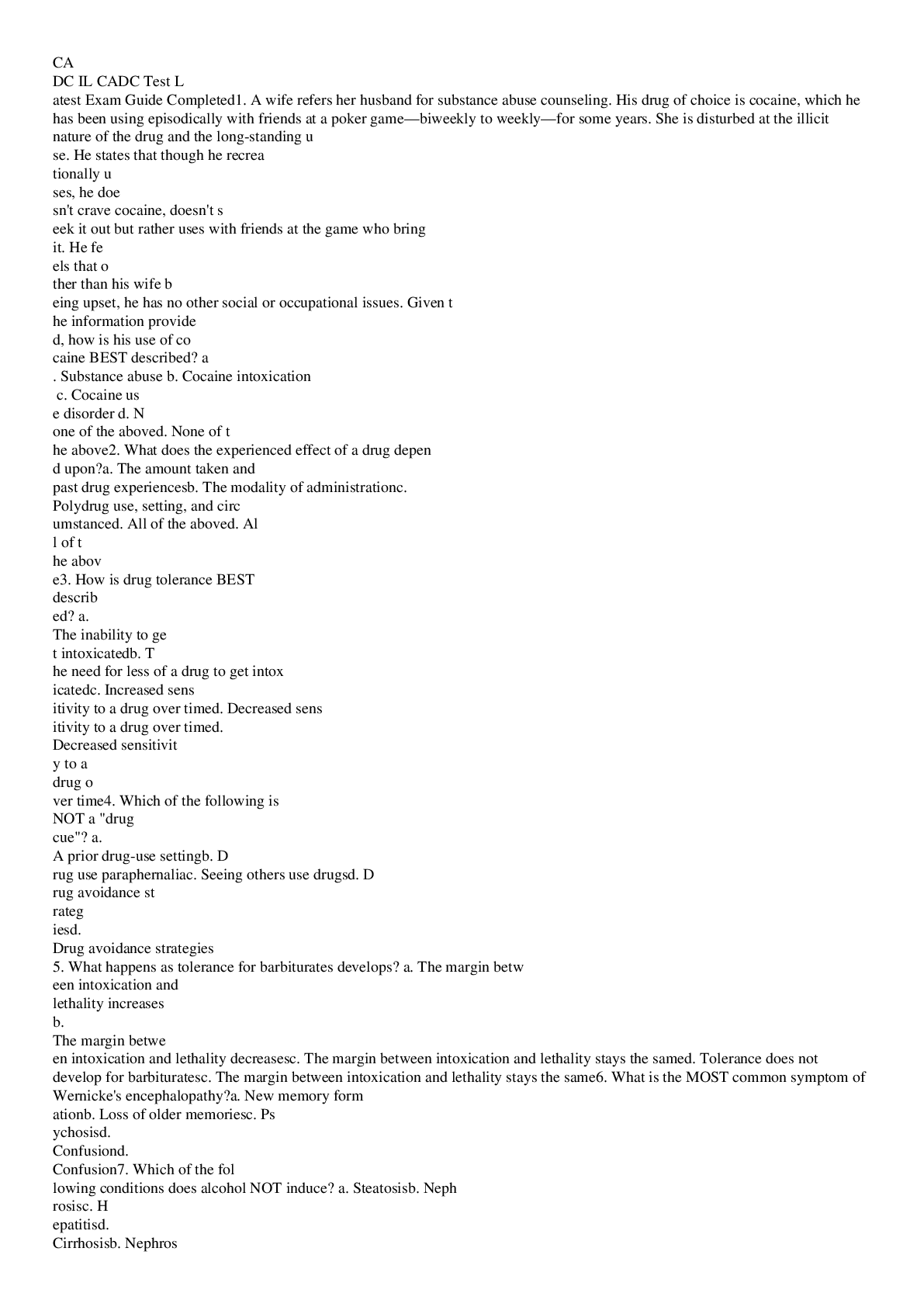
Reviews( 0 )
Document information
Connected school, study & course
About the document
Uploaded On
Oct 16, 2022
Number of pages
25
Written in
Additional information
This document has been written for:
Uploaded
Oct 16, 2022
Downloads
0
Views
47



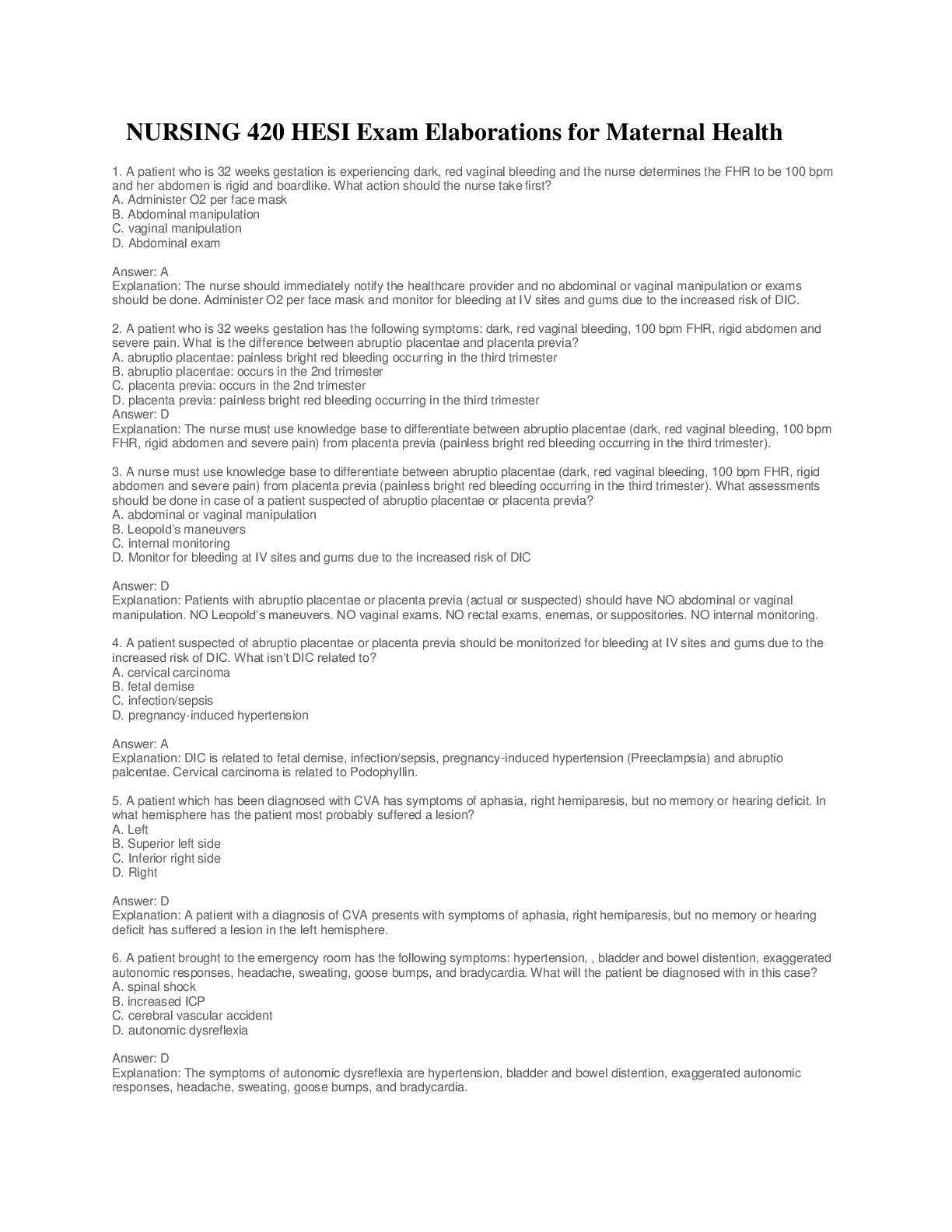

.png)

